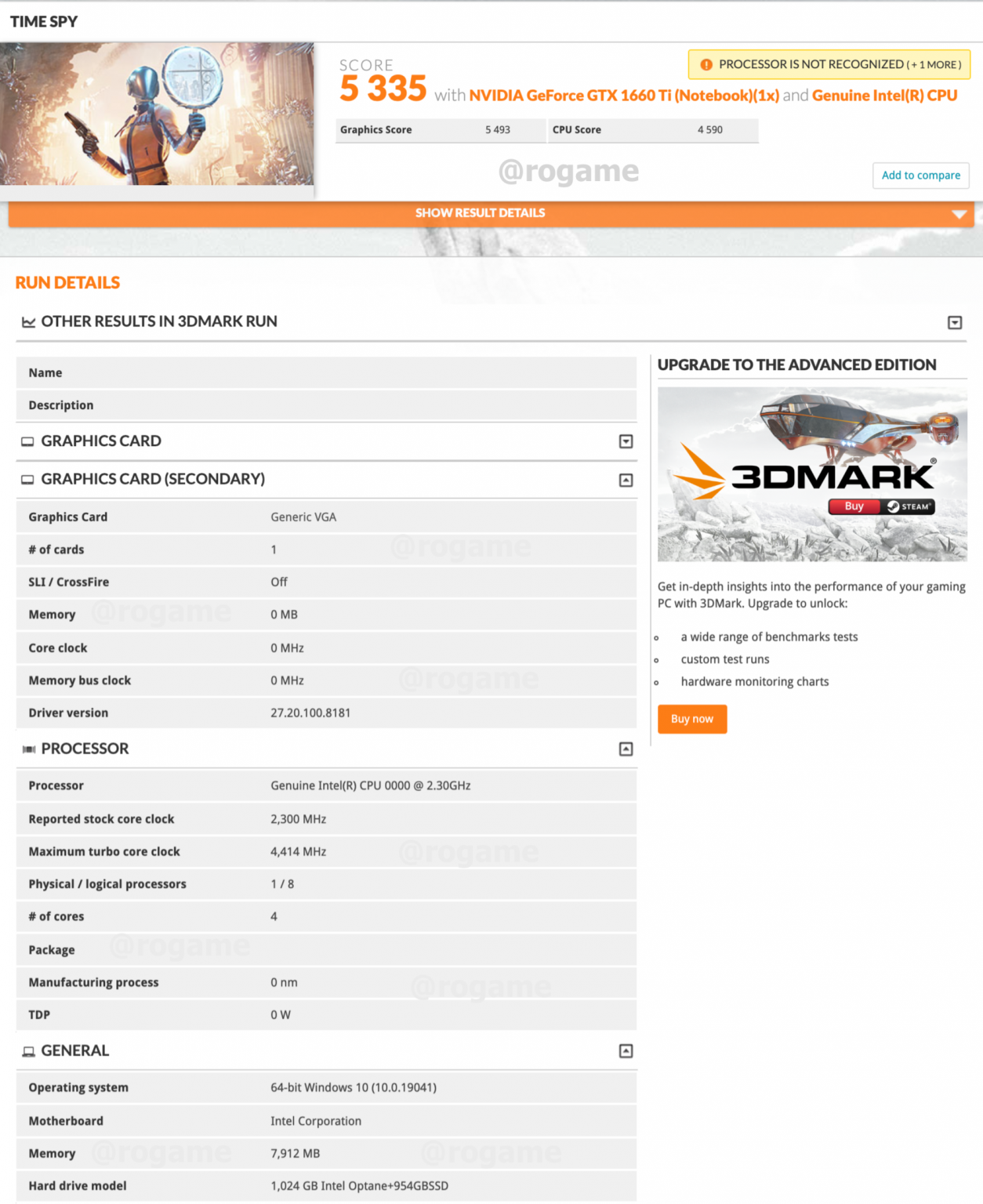One of Intel's unreleased NUC 11 Extreme devices has popped up in 3DMark's database. HardwareLeaks spotted one model that packs a quad-core Tiger Lake-U processor in conjunction with Nvidia's GeForce GTX 1660 Ti graphics card and 8GB of memory.
Intel will reportedly divide the NUC 11 family into two branches: the NUC 11 Extreme (Phantom Canyon) for enthusiasts and gamers, and the NUC 11 Performance (Panther Canyon) for mainstream users. Predictably, the former will employ the more powerful Tiger Lake-U chips and also come with discrete graphics card options. As a quick reminder, Tiger Lake leverages Willow Cove cores, and Intel produces these new processors on the 10nm+ process node. It's not official yet, but Tiger Lake should adopt the 11th Generation branding.
3DMark identifies the Tiger Lake-U chip inside the NUC 11 Extreme as a quad-core, eight-thread design. This Tiger Lake-U silicon appears to have a 2.3 GHz base clock and 4.4 GHz boost clock, which is quite decent for an engineering sample (ES) and better than the maximum 4.1 GHz boost found with its Ice Lake predecessors. Being unreleased silicon, many of its parameters aren't available and could be subject to change. However, if the leaked PowerPoint slide from last year is genuine, the Tiger Lake-U chip could have a 28W TDP (thermal design power). The slide also alluded to PCIe 4.0 support.

On the integrated graphics end, Tiger Lake-U is rumored to feature Gen12 Xe graphics. Nevertheless, one of the more attractive features on the NUC 11 Extreme is the possibility to enjoy the perks of having a discrete graphics card. The model from the 3DMark submission seemingly sports the mobile variant of the GeForce GTX 1660 Ti. You still receive the same 1,536 CUDA cores and 6GB of 12 Gbps GDDR6 memory as the desktop variant, albeit at slower clock speeds to comply with the 80W envelope.
All the information thus far puts the NUC 11 Extreme inside a 1.35-liter case, placing the footprint in the same territory as the next-generation consoles, such as the PlayStation 5 or Xbox Series X. The GeForce GTX 1660 Ti might not be enough to really compete with the consoles, though. Both the PlayStation 5 or Xbox Series X use AMD's Navi 2x GPUs, which are good for up to 10.3 TFLOPS and 12.1 TFLOPS, respectively. The GeForce GTX 1660 Ti Mobile only delivers 4.8 TFLOPS of FP32 performance. The NUC 11 Extreme would need at least a GeForce RTX 2080 Super Mobile to match the consoles' performance — that is, of course, assuming that Intel wants the NUC 11 Extreme to compete against the new consoles.
An unverified Intel NUC roadmap estimated the NUC 11's arrival in the second half of this year. The roadmap dates before the coronavirus pandemic so Intel's plans have probably changed.
Stay On the Cutting Edge: Get the Tom's Hardware Newsletter
Get Tom's Hardware's best news and in-depth reviews, straight to your inbox.

Zhiye Liu is a news editor and memory reviewer at Tom’s Hardware. Although he loves everything that’s hardware, he has a soft spot for CPUs, GPUs, and RAM.
-
TCA_ChinChin More interested in the mainstream model rather than the extreme model, but if they manage to at least take the Tiger Lake-U processor and push that into the mainstream NUC 11, then it'll be a pretty interesting product. Also looking forward to AMD APU competitors in the NUC and NUC-like space in the next year or so.Reply -
Deicidium369 Reply
Agreed. I will be replacing several generations of NUCs (65 or so) with the NUC11. We are not running into a lack of computational power - our issues are video - some employees are struggling with dual 2560x1440 monitors, and others with dual 4Ks (my employees can choose their monitor config as well as keyboard and mice). So the Xe LP on the TGL will be a welcome upgrade. Would have preferred a SFP+ network option, but the 2.5Gb/s is still and upgrade.TCA_ChinChin said:More interested in the mainstream model rather than the extreme model, but if they manage to at least take the Tiger Lake-U processor and push that into the mainstream NUC 11, then it'll be a pretty interesting product. Also looking forward to AMD APU competitors in the NUC and NUC-like space in the next year or so.
With the high perf at 4.4GHz - seems like Intel has both the yields and the clocks worked out. -
Deicidium369 Reply
Would you like a cookie?Tpoke1985 said:My i7-8565U reguarly roared to life at 4.6ghz boost in a 700 media laptop :/ -
spongiemaster Reply
Different architecture. A 4.4 Ghz Tiger Lake should perform like a 5.1-5.3Ghz Whiskey Lake. In other words, quite a bit faster.Tpoke1985 said:My i7-8565U reguarly roared to life at 4.6ghz boost in a 700 media laptop :/ -
bit_user Reply
Also, the base clock of that model CPU is allegedly just 1.8 GHz, which is substantially lower than the claimed 2.3 GHz, for the upcoming model. Still, not bad for a 15W laptop chip.spongiemaster said:Different architecture. A 4.4 Ghz Tiger Lake should perform like a 5.1-5.3Ghz Whiskey Lake. In other words, quite a bit faster.
https://ark.intel.com/content/www/us/en/ark/products/149091/intel-core-i7-8565u-processor-8m-cache-up-to-4-60-ghz.html
Unless anyone knows differently, I presume the claimed "Max Turbo" frequency is at the 25W TDP-up setting.
I'm telecommuting on a 45W i7-6820HQ with a "Max Turbo" of just 3.6 GHz, although my base clocks are 2.7 GHz.
Truth be told, I sort of hate it, because the fans can get really loud when it approaches anything near that. And between the security software my employer has running on it plus whatever Win10 is doing, it just seems to happen at random. So, I've taken to configuring the plugged-in "Max CPU" power setting to just 85% or 90%. -
Deicidium369 Replyspongiemaster said:Different architecture. A 4.4 Ghz Tiger Lake should perform like a 5.1-5.3Ghz Whiskey Lake. In other words, quite a bit faster.bit_user said:Also, the base clock of that model CPU is allegedly just 1.8 GHz, which is substantially lower than the claimed 2.3 GHz, for the upcoming model. Still, not bad for a 15W laptop chip.
https://ark.intel.com/content/www/us/en/ark/products/149091/intel-core-i7-8565u-processor-8m-cache-up-to-4-60-ghz.html
Unless anyone knows differently, I presume the claimed "Max Turbo" frequency is at the 25W TDP-up setting.
I'm telecommuting on a 45W i7-6820HQ with a "Max Turbo" of just 3.6 GHz, although my base clocks are 2.7 GHz.
Truth be told, I sort of hate it, because the fans can get really loud when it approaches anything near that. And between the security software my employer has running on it plus whatever Win10 is doing, it just seems to happen at random. So, I've taken to configuring the plugged-in "Max CPU" power setting to just 85% or 90%.
The APU listed here would only be in a semi DTR form factor - only question is will it be available in the standard NUC11 (~4.5"x4.5") or just the Extreme NUC. Still this is an engineering sample - but heading in the right direction - soon the design/clocks will be locked in and start to ship.
I am glad that I am retired and don't need to lug around an almost DTR system - just my 1065G7 Dell 13 2-in-1 - and even then I only put a couple hundred hours per year on it - wife uses hers alot more than I use mine.
Bring on the NUC11 Non Extreme, non 2.5" drive capable, 2.5Gb/s Ethernet (don't mind replacing my 1Gb/s non PoE switches - would rather just use SFP+ and use the fiber that goes to everyone's system, and flatten the network).. 3 Generations of NUCs will be finding new homes. -
Giroro No mention that this configuration apparently used a 1 TB Optane drive that doesn't officially exist, and would probably cost more than the NUC itself?Reply -
spongiemaster ReplyDeicidium369 said:I am glad that I am retired and don't need to lug around an almost DTR system
FOUR posts earlier in this thread:
Deicidium369 said:I will be replacing several generations of NUCs (65 or so) with the NUC11. We are not running into a lack of computational power - our issues are video - some employees are struggling with dual 2560x1440 monitors, and others with dual 4Ks (my employees can choose their monitor config as well as keyboard and mice). So the Xe LP on the TGL will be a welcome upgrade
Seriously chief, WTF? -
Deicidium369 Replyspongiemaster said:FOUR posts earlier in this thread:
Seriously chief, WTF?
Not sure what was with the first part - I am retired - for ~20 years at age 28 or 29 when I sold my 2nd ISP. I reired from doing things I didn't want to to make a living - and didn't want to deal with investors anymore. I still put in 40+ hours per week among 3 ventures and various hobbies. The office described below is the main administration - C levels (CEO CFO COO) as well as accounting, HR, Benefits Admin, Legal, Fleet & Logistics. Certain functions (Accounting, HR, Legal, Benefits admin) are shared among all 3 businesses. All said and done over 1000 employees in total.
I use Intel NUCs and primarily Dell monitors.
I build a bracket, about 4.5" x 11" out of stainless steel. On both ends I drill out of the 100mm VESA bolt pattern, and put 2 90deg bends in it. I end gets sandwiched between the monitor and the stand - and the other is used to mount the NUC. I got a 14" DP cable and an 18" USB cable from Monoprice. DP and USB connect to monitor (has USB hub). I have a Y spliter for standard AC cables (like the ones that connect to your PC). 1 goes to monitor - other to the NUC PS. I replace the PS that comes with the NUC and source a better unit - but most importantly - it has a standard AC power in, and I have 12" DC barrel to barrel cord from PS to NUC and is rectilinear without convex sides. PS is mounted between the NUC and the monitor stand, and is held on with Velcro.
My employees can choose wired or wireless keyboards and can choose single or dual monitors.
So this forms basically an AiO - no cables, no overkill PC case, etc. Keeps things neat and tidy. The oldest NUCs have enough processing power to handle the workload (MS Word, Excel, Project, Outlook and Chrome) - it's the video that is lagging - on the older systems dual 2560x1440 is the absolute limit - and even on the newer ones dual 4K is a bit taxing. So replacing all 65 or 66 NUCs currently deployed with the NUC11 (Tiger Lake)- will get 512GB-1TB Samsung M.2 NVMe PCIe4 and whatever the fastest SODIMMs supported - probably going to 32GB due to memory being so cheap ATM (other systems were 8-16GB). The 2.5Gb/s Ethernet is an upgrade over the GbE. So from the wall there is 1 single AC cord + 1 single CAT6 cable going to the PC.
When we started to migrate people home due to Covid, the AiO came in very handy - no mess of cables, all they needed to do was plug in the UPS we supplied, plug in the PC, plug ijn the wall adapter for the Cisco IP Phones (no PoE at their home) and plug in the Palo Alto Networks endpoints - which were pre provisioned. The plug in the PC and the IP Phone and onto the Internet - nails up a VPN - couple of quick changes to Switchvox and people are back up and running. Kept my IT staff from having to run all over the place setting systems up - and most handled the job themselves.